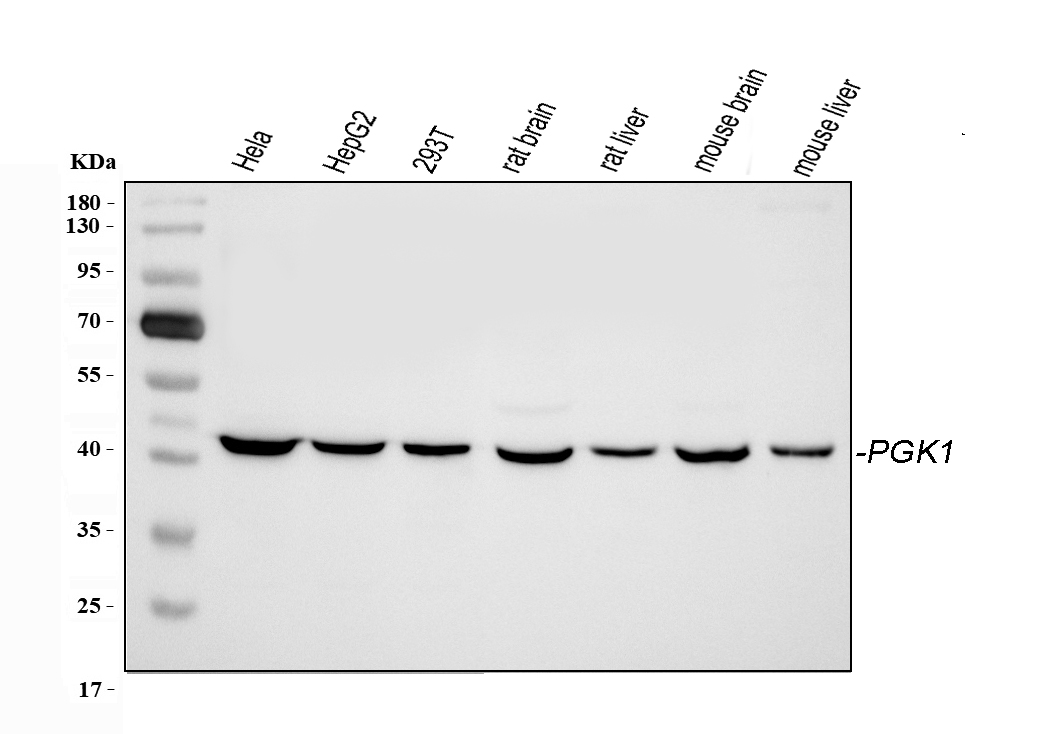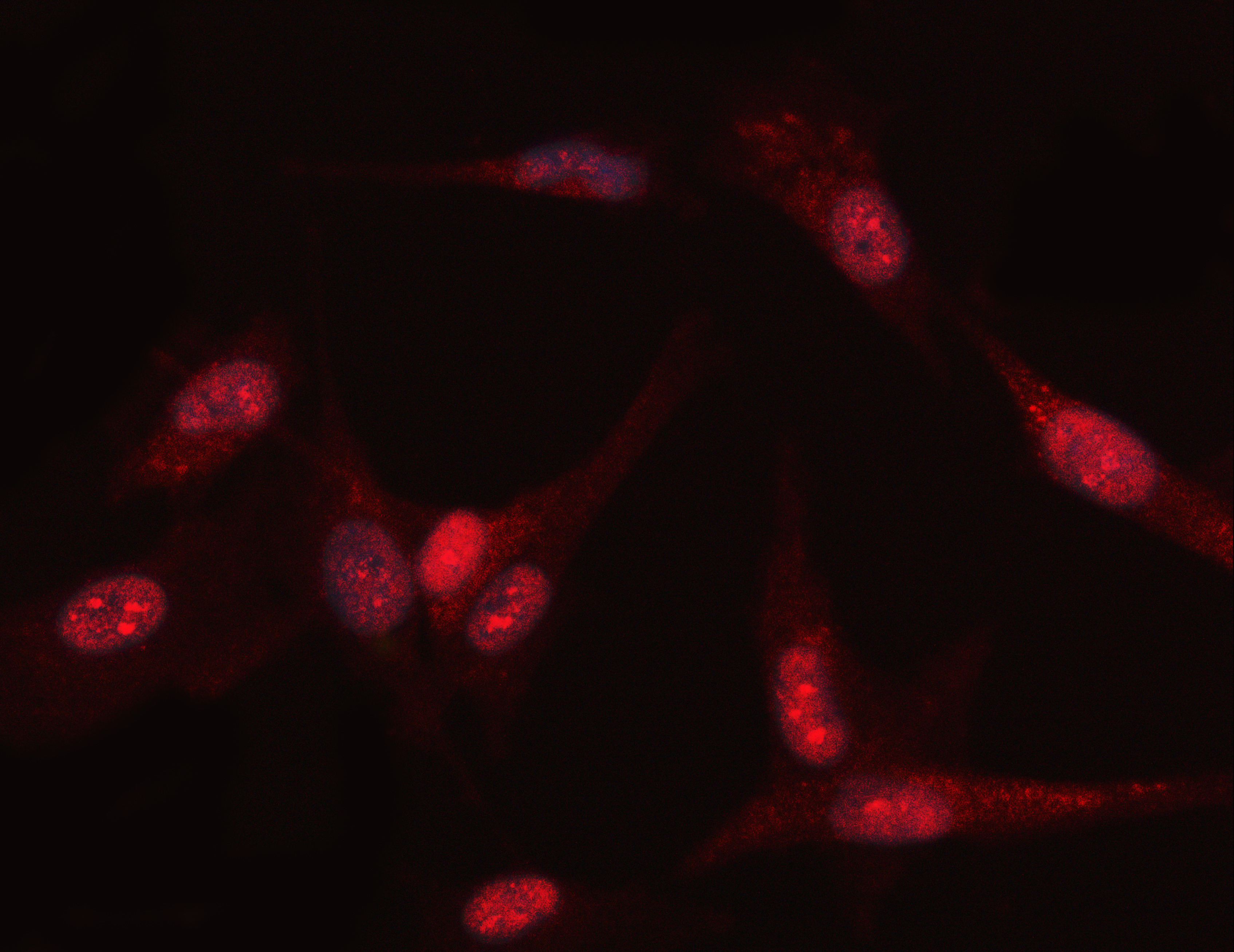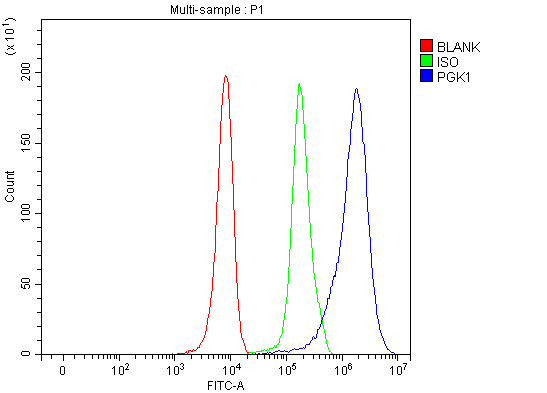| Western blot (WB): | 1:500-2000 |
| Immunocytochemistry/Immunofluorescence (ICC/IF): | 1:50-400 |
| Flow Cytometry (Fixed): | 1:50-200 |

Western blot analysis of PGK1 using anti-PGK1 antibody (PB0824). The sample well of each lane was loaded with 30 ug of sample under reducing conditions.
Lane 1: Hela whole cell lysates,
Lane 2: HepG2 whole cell lysates,
Lane 3: 293T whole cell lysates,
Lane 4: rat brain tissue lysates,
Lane 5: rat liver tissue lysates,
Lane 6: mouse brain tissue lysates,
Lane 7: mouse liver tissue lysates.
After electrophoresis, proteins were transferred to a membrane. Then the membrane was incubated with rabbit anti-PGK1 antigen affinity purified polyclonal antibody (PB0824) at a dilution of 1:1000 and probed with a goat anti-rabbit IgG-HRP secondary antibody (Catalog # BA1054). The signal is developed using ECL Plus Western Blotting Substrate (Catalog # AR1197). A specific band was detected for PGK1 at approximately 45 kDa. The expected band size for PGK1 is at 45 kDa.

IF analysis of PGK1 using anti-PGK1 antibody (PB0824).
PGK1 was detected in an immunocytochemical section of U-87MG cells. The section was incubated with rabbit anti-PGK1 Antibody (PB0824) at a dilution of 1:100. Cy3-conjugated Anti-rabbit IgG Secondary Antibody (red)(Catalog#BA1032) was used as secondary antibody.

Flow Cytometry analysis of 293T cells using anti-PGK1 antibody (PB0824).
Overlay histogram showing 293T cells stained with PB0824 (Blue line). To facilitate intracellular staining, cells were fixed with 4% paraformaldehyde and permeabilized with permeabilization buffer. The cells were blocked with 10% normal goat serum. And then incubated with rabbit anti-PGK1 Antibody (PB0824) at 1:100 dilution for 30 min at 20°C. DyLight®488 conjugated goat anti-rabbit IgG (BA1127) was used as secondary antibody at 1:100 dilution for 30 minutes at 20°C. Isotype control antibody (Green line) was rabbit IgG at 1:100 dilution used under the same conditions. Unlabelled sample without incubation with primary antibody and secondary antibody (Red line) was used as a blank control.

Western blot analysis of PGK1 using anti-PGK1 antibody (PB0824). The sample well of each lane was loaded with 30 ug of sample under reducing conditions.
Lane 1: Hela whole cell lysates,
Lane 2: HepG2 whole cell lysates,
Lane 3: 293T whole cell lysates,
Lane 4: rat brain tissue lysates,
Lane 5: rat liver tissue lysates,
Lane 6: mouse brain tissue lysates,
Lane 7: mouse liver tissue lysates.
After electrophoresis, proteins were transferred to a membrane. Then the membrane was incubated with rabbit anti-PGK1 antigen affinity purified polyclonal antibody (PB0824) at a dilution of 1:1000 and probed with a goat anti-rabbit IgG-HRP secondary antibody (Catalog # BA1054). The signal is developed using ECL Plus Western Blotting Substrate (Catalog # AR1197). A specific band was detected for PGK1 at approximately 45 kDa. The expected band size for PGK1 is at 45 kDa.

IF analysis of PGK1 using anti-PGK1 antibody (PB0824).
PGK1 was detected in an immunocytochemical section of U-87MG cells. The section was incubated with rabbit anti-PGK1 Antibody (PB0824) at a dilution of 1:100. Cy3-conjugated Anti-rabbit IgG Secondary Antibody (red)(Catalog#BA1032) was used as secondary antibody.

Flow Cytometry analysis of 293T cells using anti-PGK1 antibody (PB0824).
Overlay histogram showing 293T cells stained with PB0824 (Blue line). To facilitate intracellular staining, cells were fixed with 4% paraformaldehyde and permeabilized with permeabilization buffer. The cells were blocked with 10% normal goat serum. And then incubated with rabbit anti-PGK1 Antibody (PB0824) at 1:100 dilution for 30 min at 20°C. DyLight®488 conjugated goat anti-rabbit IgG (BA1127) was used as secondary antibody at 1:100 dilution for 30 minutes at 20°C. Isotype control antibody (Green line) was rabbit IgG at 1:100 dilution used under the same conditions. Unlabelled sample without incubation with primary antibody and secondary antibody (Red line) was used as a blank control.


